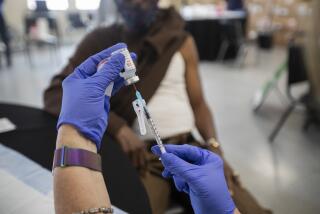California is cutting preventable hospitalizations
- Share via
California is doing a better job at cutting the number of unnecessary hospitalizations, but members of some minority groups, particularly African Americans, are still being hospitalized too often, according to recently released state reports that cite lack of access to regular healthcare as a prime source of the problem.
“The problem seems to be getting better over time as we improve the prevalence of health insurance,” said Dr. David Carlisle, director of the Office of Statewide Health Planning and Development, which released the reports last week. However, disparities persist, he said.
The rate of hospitalizations decreased 6.8% statewide from 1999 to 2008, the most recent year available, when 313,841 patients were hospitalized at a cost of about $3.6 billion, according to one of the reports which was based on data collected from all state-licensed hospitals.
State researchers tracked 15 medical conditions for which hospitalizations are considered preventable and found hospitalizations decreased for 10 of them from 1999 to 2008, most notably chest pain, down more than 60%, and pediatric gastroenteritis and chronic obstructive pulmonary disease, down more than 45%.
However, hospitalizations increased for three other conditions: long-term complications associated with diabetes, urinary tract infections and hypertension, which increased sharply during the last two years of the study. The rates of hospitalizations for two other diabetes-related conditions remained relatively unchanged.
There are multiple reasons why health policymakers are focused on keeping people out of hospitals. One is cost — it is typically less expensive to treat people in outpatient settings than in hospitals. Another is safety. Many patients pick up infections or encounter other problems after entering hospitals. And it is generally believed that increased access to regular healthcare reduces the amount of time people spend in hospitals.
Dylan Roby, an assistant professor of health services based at the UCLA Center for Health Policy Research, called the report “a bad sign” for preventable hospitalizations.
“Where we’re seeing spikes is in conditions where we want it to go down,” Roby said.
Preventable hospitalizations for hypertension were particularly high in the largely African American area of South Los Angeles — more than three times the statewide rate. In the same area, the rate of preventable hospitalizations was more than twice the statewide rate for 10 other conditions researchers measured, including congestive heart failure, adult asthma and lower-extremity amputation for patients with diabetes.
“It really speaks to access to care,” said Debby Rogers, vice president of quality and emergency services at the California Hospital Assn. “Hospitals are always concerned with whether patients are going to be able to get follow-up care, and we know in some geographic areas that’s harder.”
By comparison, preventable hospitalizations for hypertension were lower than the state rate in Ventura County, and only slightly higher than the state rate in Orange, Riverside and San Bernardino counties.
The second report showed African Americans had the highest hospitalizations rate of any ethnic group in the state, about 13%, followed by whites (11%) Latinos (8.6%), Asians (6.7%) and Native Americans (3.9%) as of 2007, the most recent year available.
African Americans also had higher rates of disease for 14 of 16 medical conditions researchers used to measure access to outpatient care, often two to three times the rates of whites, even after adjusting for age and gender differences, according to the second report.
Studies have shown that African Americans may be more prone to develop chronic diseases, but that is not the only factor driving the disparities in hospitalizations, state officials said. Other factors may include patients’ lack of insurance, access to quality outpatient healthcare, demanding work schedules and lack of transportation.
State researchers will provide Los Angeles County health officials with detailed ZIP Code-level data to help establish whether certain areas of the county are medically underserved and eligible for added healthcare funding, Carlisle said.
State and county officials might also help reduce unnecessary hospitalizations by improving the medical safety net for the uninsured and connecting those in need of insurance with the new state health insurance exchange, Roby said. But he said much of the burden of preventing hospitalizations will fall on hospitals themselves.
“If they have better referral mechanisms and can provide better support for primary care physicians as they try to manage a case, then I think they will be able to prevent hospitalizations,” he said. “You can have a well-insured population, but if they work nights, or they have a really high deductible, they may have to delay it, and end up in the hospital. We need to really focus on getting people into primary care.”
Hospital officials took note of the reports, but have already been improving out-patient care, in part to avoid penalties under the new healthcare laws for rapidly readmitting Medicare patients, said Jim Lott, executive vice president of the Hospital Assn. of Southern California.
molly.hennessy-fiske@latimes.com







